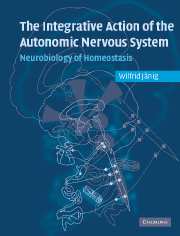Book contents
- Frontmatter
- Contents
- Foreword
- Preface
- List of abbreviations
- Introduction
- Part I The autonomic nervous system: functional anatomy and visceral afferents
- Part II Functional organization of the peripheral autonomic nervous system
- Part III Transmission of signals in the peripheral autonomic nervous system
- Part IV Central representation of the autonomic nervous system in spinal cord, brain stem and hypothalamus
- Chapter 8 Anatomy of central autonomic systems
- Chapter 9 Spinal autonomic systems
- Chapter 10 Regulation of organ systems by the lower brain stem
- Chapter 11 Integration of autonomic regulation in upper brain stem and limbic-hypothalamic centers: a summary
- References
- Index
Chapter 10 - Regulation of organ systems by the lower brain stem
Published online by Cambridge University Press: 10 August 2009
- Frontmatter
- Contents
- Foreword
- Preface
- List of abbreviations
- Introduction
- Part I The autonomic nervous system: functional anatomy and visceral afferents
- Part II Functional organization of the peripheral autonomic nervous system
- Part III Transmission of signals in the peripheral autonomic nervous system
- Part IV Central representation of the autonomic nervous system in spinal cord, brain stem and hypothalamus
- Chapter 8 Anatomy of central autonomic systems
- Chapter 9 Spinal autonomic systems
- Chapter 10 Regulation of organ systems by the lower brain stem
- Chapter 11 Integration of autonomic regulation in upper brain stem and limbic-hypothalamic centers: a summary
- References
- Index
Summary
Sympathetic and parasympathetic premotor neurons are present in the lower brain stem (medulla oblongata and pons) in addition to those located more rostrally (see Chapter 8.4). Their cell bodies are located in the ventrolateral medulla (mainly rostral ventrolateral medulla), the ventromedial medulla, the caudal raphe nuclei and the A5 area of the ventrolateral pons (see Figures 8.15 and 8.17 and Tables 8.2 and 8.3). Premotor neurons form synapses with preganglionic neurons (and/or local interneurons associated with the preganglionic neurons) (Chapters 8, 9). How do autonomic premotor neurons in the lower brain stem function so as to contribute to the characteristic discharge patterns of the neurons of the peripheral autonomic pathways? Are they specialized for the behavioral repertoire of the organism? Are there discharge patterns similar to those seen in the neurons of the final autonomic pathways (see Chapter 4)?
On the basis of the knowledge we have about the central autonomic systems, I can partially answer these questions for some systems in the lower brain stem. These answers, incomplete as they may be, clearly indicate that we will be able to unravel the maze of the neural organization of autonomic systems in the lower brain stem in the near future. One of the first decisive and important steps to reach this aim, particularly for the cardiovascular system, was and still is to record the effects of microinjection of pharmacological agents into defined regions of the lower brain stem on effector responses (e.g., arterial blood pressure, heart rate, blood flow through an organ).
- Type
- Chapter
- Information
- Integrative Action of the Autonomic Nervous SystemNeurobiology of Homeostasis, pp. 375 - 458Publisher: Cambridge University PressPrint publication year: 2006



